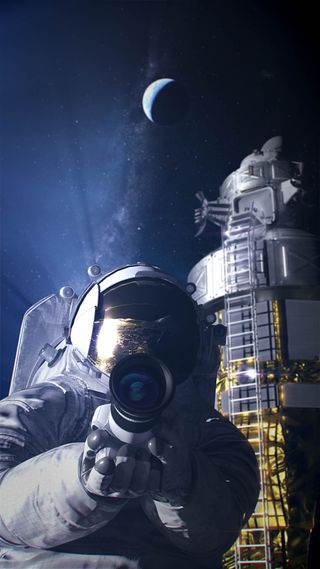Moon 2024: NASA Wants Ideas for Lunar Spacesuit Tech
NASA wants the private sector to eventually help manufacture the new xEMU suit.

NASA is looking to the private sector to help mature and manufacture the spacesuit it will need for its future moon missions, the first of which is targeted for 2024.
The space agency plans to build and certify the new spacesuit, which is known as the Exploration Extravehicular Mobility Unit (xEMU). The first few suits, made in house, will be tested on the International Space Station in 2023 and worn by the astronauts who touch down on the lunar surface in 2024 on the Artemis III mission. (Artemis is NASA's ambitious crewed lunar-exploration program, which aims to establish a long-term, sustainable human presence on and around the moon by 2028.)
But NASA wants some aid from industry thereafter. On Friday (Oct. 4), the agency published a request for information (RFI), asking for industry feedback to "refine and mature the acquisition strategy for production and services for lunar spacesuits," as NASA officials explained in a statement. (You can view the RFI here.)
Related: Can NASA Really Put Astronauts on the Moon in 2024?
"After Artemis III, NASA plans to transition responsibility for production, assembly, testing, sustaining and maintenance of a fleet of flight and training spacesuits and associated hardware to U.S. industry," NASA officials added.
The xEMU could be adapted for other destinations besides the moon, such as Mars. It will use more advanced technology than the 50-year-old Apollo moon spacesuits and allow astronauts to walk comfortably on solid ground, unlike NASA's current crop of spacesuits, which are tailored for spacewalks outside the ISS.
NASA plans to get industry feedback on how to improve the initial spacesuit design, how industry would produce the new threads, how to produce and maintain tool kits and hardware for the moonwalks, and how each company would improve the suits over time. The discussion will also include how to commercialize parts of the suits or associated items (such as tools) for non-NASA customers.
Get the Space.com Newsletter
Breaking space news, the latest updates on rocket launches, skywatching events and more!
Lunar astronauts will have a lot of design changes to look forward to, compared with older types of spacesuits. One of the most famous parts of the Apollo missions in the 1960s and 1970s — the bunny hop astronauts used to move around on the lunar surface — will no longer be needed, because the xEMU will incorporate significant mobility improvements, NASA officials said. For example, the lower torso of the spacesuit will use bearings and other components to let astronauts walk or even kneel while doing their experiments and geology work.
NASA also plans changes to make it easier to accommodate different body sizes, an issue that cropped up on the ISS earlier this year when spacesuit fit requirements postponed the first all-female spacewalk from March to October, if all goes according to plan. There will be spacesuit changes for comfort and fit, as well as a new life-support system with easily swappable components to accommodate technology improvements.
"The new exploration suit can be used in spacewalks that may vary with dust, thermal conditions, operational requirements such as walking, driving rovers, or collecting samples, or gravity," NASA officials added in the statement.
The agency plans to use variations of the xEMU spacesuit at the ISS, on the future Gateway lunar space station and on future missions to Mars.
- The Evolution of the Spacesuit in Pictures
- Scientists Test Mars Spacesuit By Climbing a Glacier in Iceland
- This Next-Gen Spacesuit Could Protect Astronauts on the Moon and Mars
Follow Elizabeth Howell on Twitter @howellspace. Follow us on Twitter @Spacedotcom and on Facebook.

Join our Space Forums to keep talking space on the latest missions, night sky and more! And if you have a news tip, correction or comment, let us know at: community@space.com.

Elizabeth Howell (she/her), Ph.D., is a staff writer in the spaceflight channel since 2022 covering diversity, education and gaming as well. She was contributing writer for Space.com for 10 years before joining full-time. Elizabeth's reporting includes multiple exclusives with the White House and Office of the Vice-President of the United States, an exclusive conversation with aspiring space tourist (and NSYNC bassist) Lance Bass, speaking several times with the International Space Station, witnessing five human spaceflight launches on two continents, flying parabolic, working inside a spacesuit, and participating in a simulated Mars mission. Her latest book, "Why Am I Taller?", is co-written with astronaut Dave Williams. Elizabeth holds a Ph.D. and M.Sc. in Space Studies from the University of North Dakota, a Bachelor of Journalism from Canada's Carleton University and a Bachelor of History from Canada's Athabasca University. Elizabeth is also a post-secondary instructor in communications and science at several institutions since 2015; her experience includes developing and teaching an astronomy course at Canada's Algonquin College (with Indigenous content as well) to more than 1,000 students since 2020. Elizabeth first got interested in space after watching the movie Apollo 13 in 1996, and still wants to be an astronaut someday. Mastodon: https://qoto.org/@howellspace
Most Popular

